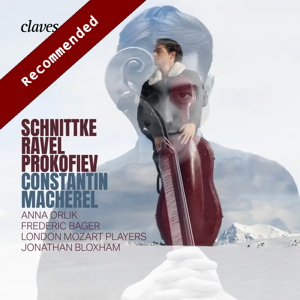
Maurice Ravel (1875-1937)
Sonata for Violin and Cello
Alfred Schnittke (1934-1998)
Sonata for Cello and Piano No.1 (1978)
Sergei Prokofiev (1891-1953)
Symphony-Concerto in E Minor, Op.125
Constantin Macherel (cello), Anna Orlik (violin), Frederic Bager (piano), London Mozart Players/Jonathan Bloxham
rec. 2022/2023, Espace Consonance Saxon, Switzerland; St John the Evangelist Church, Upper Norwood, London, UK
Claves 50-3097 [80]
It occurs to me that the composers on this disc died rather early, in their sixties, but they all vastly influenced the twentieth-century music. Take Maurice Ravel, never mind the overplayed Bolero or La Valse, with his innovative writing. The brilliant String Quartet in G minor includes a wonderful pizzicato Aseez vif second movement. The first movement of the Piano Trio in A minor is deliciously romantic. The second movement of the Violin Sonata No.2,marked Blues, suggests a gypsy camp fire at which one might expect to find Django Rheinhardt!
The Sonata for Violin and Cellohas many such touches. The spare first movement gives no hint of what is to come. It was born as a duo for violin and cello, submitted to La Revue musicale in response to a request for pieces for a planned December 1920 memorial supplement in tribute to Debussy, who died in March 1918. The duo became the first movement of the sonata completed in 1922 with the dedication “To the memory of Claude Debussy”. The third movement is equally spare. In complete contrast, the Très vif second movement lives up to the very lively marking. The sonata employs catchy tunes, reintroduced in the last movement with deeper exploration.
Alfred Schnittke was born in the Volga German Autonomous Soviet Socialist Republic. It was abolished in 1941 at the outbreak of the Nazi invasion of the Soviet Union, and the citizens deported as far away as to Kazakhstan. Schnittke completed his studies in Moscow in 1961, where he then taught in 1962-1972. He created what he called polystylism, in which he sought to combine different styles. He said: “The goal of my life is to unify serious music and light music, even if I break my neck in doing so.”
Yaël Hêche, the booklet-note writer, says that Schnittke’s Sonata for Cello and Piano No.1 continues this approach, but I cannot detect much light. I find the outer movements rather bleak. The first movement is introspective. The central Presto is a real test for the cellist, with a driving rhythm against a background of propulsive hammering on the piano. The finale, a heartfelt Largo, weaves elements from the two preceding movements into an overall dirge-like, grieving atmosphere. At the end, the piano disappears in ever-receding notes.
Sergei Prokofiev’s music has a recognisable, determinedly forceful presence. His melodies and harmonies may be strikingly different from the music of his contemporaries. Young Mstislav Rostropovich impressed Prokofiev so much that he wrote the Cello Sonata in C majorfor the 22 year-old cellist. Later, the 60 year-old composer rewrote his cello concerto, which Rostropovich brought back to the public’s attention ten years after the completion; it became a sinfonia concertante. Rostropovich played it in public early in 1952, Prokofiev revised it shortly before his death, and Rostropovich gave a première in December 1954.
Working closely with the soloist, Prokofiev explored every facet of the instrument, and made the work truly symphonic. The booklet very rightly says that it should more accurately be described as a symphonic concerto. The orchestra’s role – by no means simply to accompany – is as significant as the soloist’s.
The work opens with a grand sweep. The cello enters with an affecting tune against a rather dark orchestral background until, seemingly calmed, the orchestra sound becomes lighter. The concerto, perhaps a distillation of Prokofiev’s musical journey, includes his signature touches: rich harmonies and tuneful melodies which often emerge from his typical spiky dissonance always softened along the way. The second, longest movement, has very moving tunes, and the cello often explores its highest register in conversation with the orchestra. The final movement has three sections. A soft-sounding opening precedes fast passages in which various instruments have a conversation with the soloist. This continues throughout the movement, and the cello has the last word. The work, rich and rewarding, reveals more with every listen.
The booklet note says correctly that there are huge differences between the three works here. Even so, there is a connection: the composers exploited the full range of the cello’s fantastic capacity to express joy, anxiety, and even sadness and despair. Its ability to plumb the deepest emotions drew many composers. The three examples here ride high on the scale of musical achievement.
All three soloists, with superb artistry, contributed to the enjoyment, but I must single out cellist Constantin Macherel, whose playing is of the very highest order. I thank him for convincing me that Prokofiev’s Symphony-Concerto is something quite special. The orchestra and conductor were also vital in my reappraisal.
I have recently also been reassessing my appreciation of Ravel’s music. I see it now as a very important influence in the twentieth-century music. Anna Orlik’s violin playing has helped that reassessment. To make Schnittke’s challenging music tunefully enjoyable is also a considerable achievement. In the hands of the two musicians here, it became a thing of beauty and joy. Pianist Frederic Bager excelled in tumultuous passages, making them completely and coherently relevant.
This is without doubt a disc to savour, unreservedly recommended.
Steve Arloff
Buying this recording via a link below generates revenue for MWI, which helps the site remain free.



















